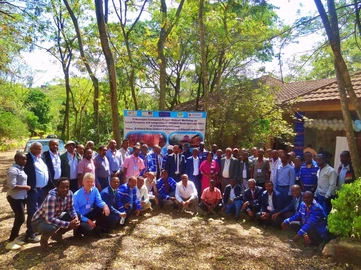ZEF-research on UNESCO World Heritage Sites in Ethiopia and Kenya launched
May 17, 2023.
A new ZEF research project kicked off with two stakeholder workshops in Ethiopia and Kenya in January 2023. The project, “Local Dynamics and Integration of UNESCO World Heritage Sites of Outstanding Universal Value: Evidence from Cultural Landscapes in Ethiopia and Kenya”, will be generously funded by the Volkswagen Foundation for the upcoming four years. The project, which will look at two UNESCO World Heritage Sites in Ethiopia and Kenya, respectively, is a partnership initiative with Dilla University in Dilla Town, Ethiopia and Kenyatta University in Nairobi, Kenya. Seven post-doc researchers from Germany, Ethiopia and Kenya with backgrounds in forestry, development studies, geography and protected area management will be working in the project.
Stakeholder workshops in Ethiopia and Kenya
The two kick-off stakeholder workshops in Dilla, Ethiopia (January 11-14, 2023), and Kilifi, Kenya (January 20-25, 2023), brought together project partners, affiliated researchers, government authorities, conservationists and traditional representatives of communities living in and with the two UNESCO World Heritage Sites. The workshops included field trips to the cultural landscapes. Some representatives of local communities shared their knowledge and expressed their concerns and views on the environmental, economic and social changes occurring in the two cultural landscapes. They also talked about their needs and their perceptions of the future. These networks and insights will be important for the empirical field work phases which are part of the project set-up.
About UNESCO World Heritage Sites
Cultural landscapes can be designated by UNESCO as World Heritage Sites through its World Heritage Convention. This implies that these Sites have a globally recognized status representing outstanding universal values, beyond those for the people living in these sites and depending on them. Cultural landscapes are not static, and many of them, especially in sub-Saharan Africa, are currently experiencing strong local dynamics inducing massive environmental, economic and social changes. This often leads to the partial or entire loss of the values and environments for which these sites had been designated in the first place. Many UNESCO World Heritage Sites have thus been facing pertinent tensions and conflicts between different stakeholder groups over the past years. The World Heritage Convention requests States Parties to ensure that their World Heritage Sites maintain the qualities for which they are inscribed. There are different systems for assessing and monitoring the state of conservation of World Heritage Sites, however, they are complex in practice.
Globally, there are 1157 UNESCO World Heritage Sites as of 2023, of which 147 located in Africa (9 in Ethiopia and 7 in Kenya). The World Heritage Convention, in effect since 1972, links concepts for the preservation of cultural properties and nature conservation.
ZEF’s research angle
Upon this backdrop, the new ZEF project aims to understand UNESCO World Heritage Sites as ‘living’ cultural landscapes that are shaped and transformed through local dynamics including context-specific socio-economic, cultural, environmental and political factors. A particular focus will be on the differences between older and younger generations of people living in these sites and different user groups. Together with a broad range of partners and stakeholders in Ethiopia and Kenya, the project will conduct empirical field work in the Konso Cultural Landscape in southern Ethiopia and the Sacred Mijikenda Kaya Forests in western Kenya.
Case studies: Konso in Ethiopia and Mijikenda Kaya Forests in Kenya
The Konso Cultural Landscape in Ethiopia was recognized by UNESCO as World Heritage Site of Outstanding Universal Value in 2011. It includes a 55 km2 arid area with stone-walled terraces and fortified settlements. It constitutes a unique example of a living cultural tradition of adaptation to a dry hostile environment stretching back more than 400 years. Konso Cultural Landscape represents the shared values, social cohesion and engineering capacities of its different communities.
The Mijikenda Kaya Forests in Kenya were inscribed as UNESCO World Heritage Sites in 2008. They consist of ten forest areas along the coast of Kenya containing the remnants of fortified villages of Mijikenda people. The villages were created in the 16th century, mostly abandoned in the early 20th century, but continue to serve as sacred sites maintained by councils of elders, and as hotspots of biodiversity.
The analysis of the case studies will be guided by transdisciplinary concepts of human-environment interactions in cultural landscapes, sustainability and intersectionality. The better understanding of UNESCO World Heritage Sites as ‘living’ and permanently changing cultural landscapes will contribute to develop approaches to maintain their sustainable futures.
Take-away messages
Some take-away messages from the two kick-off workshops are:
Both UNESCO World Heritage Sites, designated in 2011 and 2008, respectively, have been under extreme pressure due to land-use change, (over-)use of natural resources, and changes of cultural values. Therefore, UNESCO World Heritage Sites will have to adapt to these changing dynamic local contexts, if they do not want to be at risk of becoming redundant.
Photo: Participants of the kick-off workshop in Dilla, southern Ethiopia



